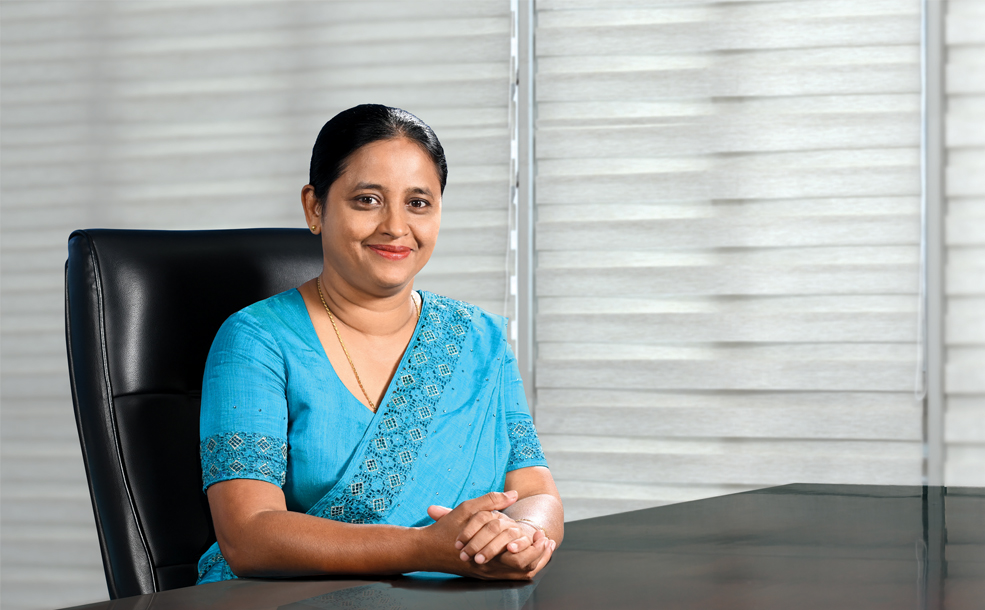Chairperson’s Message

The Bank has brought speed to its digital journey and with the UPay platform, mobile banking, and agency banking the Bank will be able to expand its services and achieve better yields in the years to come.
Dear Shareholders,
As I write my last message as the Chairperson of SANASA Development Bank, much of the rest of the world is in the grip of the COVID-19 pandemic. I mention this because it defines the future outlook of SDB bank and the country itself, which will undoubtedly be impacted.
In this moment, when the world is looking for alternative ways of being and doing business while developing and maintaining more sustainable and resilient systems, I urge our shareholders to look more closely at this institution in which you have invested. I ask you do so because I feel our Bank is ready to rise to the occasion and grow as a true leader of co-operative financing and enable the Post Covid-19 Sri Lankan community to be stronger and more resilient, both financially and socially.
Some of you may know that SANASA Development Bank was created by the SANASA Movement in 1997 to strengthen a vision embraced by one million people, who believed in self-reliance and were committed to building a social order based on co-operative principles and values. SANASA had been working towards that vision for 20 years, before they created SANASA Development Bank. The Bank was one of the four pillars that was expected to facilitate the co-operative movement to enter and compete in the market economy as an alternative force, building and strengthening co-operative enterprises and deepening finance to rural communities.
The Bank envisioned by its founders under the leadership of Dr Kiriwandeniya was inseparable from the SANASA Movement. Building on the development interventions of the SANASA Movement and guided by common people’s aspirations, this institution, in addition to conducting banking services, was to serve as the apex financial institution for the co-operative sector. The uniqueness expected from SANASA Development Bank when it was launched, compared to other banks, was that the products and services were not only to be tailor-made to the needs of the people but would also be crafted with the active collaboration of co-operative activists working intimately with their member. In other words, the experience and wisdom of the thrift and credit co-operative movement would inform the development of products and services.
The Bank was expected to create a new way of doing business and understand the people in a much more intimate manner, instead of “selling generic products through heavy propaganda” to people. It was envisioned that the Bank would actively engage with and serve those who tended to be neglected by the formal banking systems, offering products and services to enhance their wealth and increase their financial and life security.
SANASA Development Bank has stood with the people of this country in their darkest hours. This was evident in the aftermath of the Tsunami, during and after the end of the war, and natural calamities such as droughts, floods and landslides. The Bank developed mechanisms to enable victims to recover quickly and move forward even as it worked closely with the Central Bank of Sri Lanka to enable communities access refinance schemes designed by various governments. We have supported the State through refinance schemes and co-operative development programmes, helping reorganise communities, rebuild their lives and reintegrate with the rest of the nation after the war ended. We have been consistently recognised as one of the best microfinance models in the world and most recently, as the fasted growing SME bank in Sri Lanka.
Moving forward, we have streamlined the operations to cater to the SME customers who are the key drivers of Sri Lankan economy. With its strong relationships with other organisations of the SANASA Movement as well as market players at the top ends of value chains, SDB bank is venturing slowly into value chain financing, mainly to improve the agri industries.
As you are well aware, during the last few years SDB bank re-engineered operations and strategically shifted business focus to small and medium sector from microfinancing. While the Bank continued to support the microfinance sector by partnering in linkage financing systems with SANASA societies and other microfinance organisations, direct lending has tilted more towards SME customer segment. This required much investment in upgrading the skills of the staff, improving our brand visibility in the SME market, putting in place a stringent risk management and auditing culture, developing more sophisticated credit underwriting skills and more efficient and customer-centric products and processes.
Since these changes were integrated into the system, it was possible for the Bank to continue to function effectively even during the uncertain first few months after the advent of the Covid-19 pandemic with long periods of curfew and strict protection regimes. The staff worked from home and customers engaged with the Bank from home through digital platforms. We also facilitated special liquidity lines to co-operative societies, enabling them to better support their membership and thereby stay relevant. With the hiring of a new CEO endowed with more digital experience, the Board expected the Bank to leapfrog in its business, capitalising on the hard earned investments and networks made by the co-operative movement.
In 2019, much effort was invested to secure a stable SME portfolio despite the Easter Sunday attacks and explore more digitalised business platforms to cut costs and reach customers through better managed channels. The Bank has brought speed to its digital journey and with the UPay platform, mobile banking, and agency banking the Bank will be able to expand its services and achieve better yields in the years to come.
One of the main achievements in 2019 was meeting the minimum capital requirement to comply with the Basel III guidelines, as directed by the Central Bank of Sri Lanka (CBSL). Despite the unhealthy business environment following the Easter Sunday attacks, the Bank succeeded in raising LKR 3.2 Bn. in subordinated term debts as Tier 2 capital: LKR 1.8 Bn. from Stichting Fondsbeheer DGGF Lokaal MKB duly represented by Triple Jump B.V. and LKR 1.4 Bn. from Belgian Investment Company for Developing Countries NV/SA (BIO). This enabled us to meet regulatory requirements without compromising the ownership rights of existing shareholders.
My term ends in a challenging time when return on the shareholder investment is marginal. However, I retire with the confidence that the Bank is firmly established in the market with a stable brand, sound management system, technological platforms and a solid business focus to deliver on its mission, and generate stable returns on investments.
I extend my appreciation to our current business partners, shareholders and customers for placing your trust in us and being a part of our journey. I invite you to remain with us, engage with us and educate us on our shortcomings so that we can continue to improve our services and add value to your investment.
My sincere appreciation goes to everyone who served with me on the Board during the past nine years. Their contributions in numerous capacities were invaluable in steering the Bank during good times and hard times. I have no doubt that the present Board will ensure the integrity of policies and guide the CEO and the Management to steer the Bank to new and more promising destinations through fair weather and foul.
As you know, 2019 was a difficult year. The year 2020 has posed formidable challenges. I greatly appreciate the positive approach and the leadership of the CEO and the Corporate Management and our staff, who rose to the occasion and engaged with multiple stakeholders simultaneously to take on unexpected issues and resolve them satisfactorily.
I thank Dr Kiriwandeniya the Leader of the SANASA Movement for laying the foundation for SANASA Development Bank and the original shareholders who were simple co-operative leaders, with less sophisticated academic backgrounds but strong and resolute in their conviction that this country needs a bank that listens to the community and creates products and services the community needs. The regulatory systems, the employment unions, and even shareholders need to rethink how they should engage and support the growth of such a bank, as it has a tremendous potential to make the Sri Lankan economy strong and resilient and Sri Lanka more green and co-operative.
Sanasa Development Bank, which had a simple management system and a consistent shareholder composition when I took over as the Chairperson in 2011, has grown into a much more sophisticated bank with a diversified portfolio with improved technology platforms and management systems. As a result of being listed, the shareholder portfolio has become more diverse. This diversity has enhanced the dynamism of the Board of Directors. Despite all these changes, I am happy to mention that the Bank remains strongly committed to its original purpose of building stronger co-operative enterprises in Sri Lanka . The Bank has put in place structures to ensure this, through the Co-operative Subcommittee of the Board, the Co-operative Development Unit and a specially trained team of employees to build relationships and business with the co-operative sector. The Board, while supporting the Management to expand its business horizons, is equally committed to ensuring that our commitment to the co-operative sector as aspired by SANASA leaders remains intact and strong. I am confident that the new Chairman and current and future members of the Board as well as our Senior Management of the Bank will continue to add value to this model, and make this Bank one of the leaders of inclusive finance in Asia.
I wish the new Chairman, the Board, all our shareholders and well wishers, good health and success!

Samadanie Kiriwandeniya
Chairperson
26 February 2020